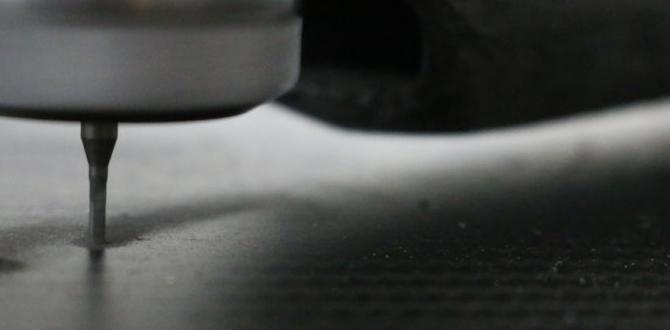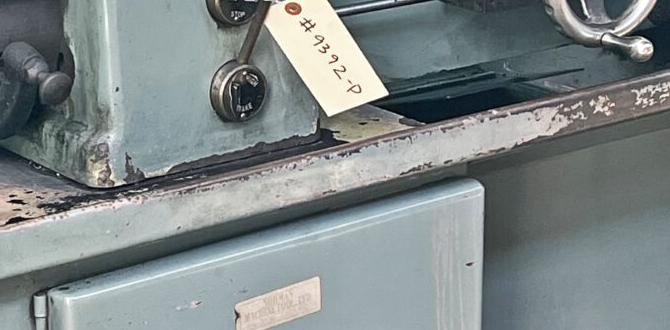Unlock the power of TiAlN ball nose end mills for D2 tool steel roughing! Master efficient material removal and achieve superior surface finishes with this beginner-friendly guide. Learn how these specialized tools simplify tough jobs, saving you time and effort in your workshop.
Ever stared at a block of tough D2 tool steel and felt a bit intimidated? D2 is famously hard, making it a challenge for many standard cutting tools. Trying to rough out pockets or complex shapes can feel like battling a bear! But what if there was a tool designed specifically to make this easier? Enter the TiAlN ball nose end mill, a real game-changer for tackling stubborn materials like D2. It’s not just another cutting tool; it’s a smart solution that can dramatically simplify your machining tasks. Let’s dive into how this “genius” tool works and how you can use it effectively in your workshop.
Why TiAlN Ball Nose End Mills are Your Secret Weapon for D2 Tool Steel
When you’re working with a material like D2 tool steel, you need tools that can handle its hardness and wear resistance. D2 is fantastic for making tools that need to stay sharp and resist wear—think stamping dies, punches, and high-performance knives. However, this toughness means it’s difficult to machine. You can’t just grab any old end mill and expect smooth, efficient cutting. That’s where specialized tooling comes in. The combination of a ball nose geometry and a Titanium Aluminum Nitride (TiAlN) coating is a winning formula for D2 roughing.
Understanding the Ball Nose Geometry
A ball nose end mill, often called a “ball end mill,” has cutting edges that form a hemispherical tip. This shape is incredibly versatile, especially for creating contours, fillets, and complex 3D surfaces. For roughing, the ball shape allows for a more engaged cutting action. It can remove material quickly in a sweeping motion, leaving a stepped surface that’s perfect for secondary finishing operations. Think of it like a tiny, precise ball that carves out material smoothly, rather than gouging it.
The Power of the TiAlN Coating
Now let’s talk about the coating: TiAlN. This isn’t just there for looks! TiAlN is a high-performance coating that provides several key benefits, especially when cutting hard materials like D2:
- Increased Hardness: TiAlN is extremely hard, helping the end mill resist wear and abrasion. This means it stays sharp for longer, even when cutting tough steels.
- High Temperature Resistance: Machining generates heat, especially with hard materials. TiAlN forms a protective layer that can withstand very high cutting temperatures, preventing the tool from softening or degrading. This hot hardness is crucial for D2.
- Reduced Friction: The coating helps to reduce friction between the tool and the workpiece. This results in cleaner cuts, less chip welding (where chips stick to the tool), and better surface finishes.
- Oxidation Resistance: It helps protect the tool from oxidizing at high temperatures, further extending its lifespan.
When you combine this robust coating with the forgiving geometry of a ball nose, you get a tool that is exceptionally well-suited for roughing D2 tool steel. It’s designed to break down the material efficiently and reliably.
D2 Tool Steel: A Quick Look at What We’re Working With
Before we get into the specifics of using your end mill, it’s helpful to understand why D2 is special. D2 is a high-carbon, high-chromium tool steel. It’s prized for its excellent wear resistance and good toughness, making it a popular choice for applications that demand durability.
However, its hardness and wear resistance also mean it can be abrasive and challenging to machine. Machining D2 requires:
- Rigid Machine Tools: You need a milling machine that’s sturdy and can handle the forces involved without excessive vibration.
- Correct Cutting Parameters: Speed, feed rate, and depth of cut need to be chosen carefully to avoid tool breakage and ensure efficient material removal.
- Appropriate Coolant/Lubrication: Keeping the cutting area cool helps extend tool life and improve surface finish.
This is precisely why a TiAlN ball nose end mill is such a smart choice. It’s built to overcome these very challenges.
How to Use Your TiAlN Ball Nose End Mill for D2 Roughing: A Step-by-Step Guide
Let’s walk through the process of using your TiAlN ball nose end mill for roughing D2 tool steel. We’ll focus on safety, efficiency, and getting the best results. Remember, always consult the manufacturer’s recommendations for specific tool recommendations and cutting parameters.
Step 1: Preparation and Setup
Before you even touch the machine, proper preparation is key. This ensures safety and better machining results.
- Secure Your Workpiece: Ensure your D2 workpiece is rigidly clamped. Use appropriate vises, clamps, or fixtures. Any movement during machining can cause tool breakage or inaccurate cuts. Safety first!
- Select the Right End Mill: Choose a TiAlN coated ball nose end mill that’s appropriately sized for your task. For example, a “tialn ball nose end mill 55 degree for tool steel d2 for roughing” implies a specific helix angle if applicable, but the primary factor is the ball diameter suitable for your desired cut.
- Set Up Your Machine: Make sure your milling machine is in good working order. Check for any play in the spindle or axes.
- Coolant/Lubrication: Have your cutting fluid or lubricant ready. For D2, a high-quality flood coolant or mistsystem is highly recommended to manage the heat generated.
- Tool Holder: Use a quality tool holder that provides good runout and rigidity. A hydraulic or shrink fit holder is ideal for high-performance machining.
Step 2: Setting Up the Z-Axis and X/Y Datum
Accurate setup is critical for precision machining.
- Find Your Z-Zero: Carefully locate the top surface of your D2 workpiece. Use a height gauge, an edge finder, or a touch probe. Set your machine’s Z-axis zero to this point.
- Set Your X/Y Datum: Similarly, identify your primary X and Y starting point on the workpiece. This is your reference point for all subsequent programmed movements.
Step 3: Choosing Your Roughing Strategy
For roughing, we’re aiming to remove bulk material quickly. Ball nose end mills excel at clearing out pockets and contours. Your strategy will often involve stepping the tool through the material.
Common roughing strategies include:
- Parallel Finishing (for contours): While often used for finishing, a stepped parallel pattern with a ball nose can also be an effective roughing strategy if designed with large stepovers.
- Pocketing: Clearing out a defined area. A ball nose can spiral into the material or clear from the outside edge.
- Adaptive Clearing: This is a more advanced CAM strategy where the tool path constantly analyzes the remaining material and adjusts its engagement to maintain a consistent chip load. This is arguably the most efficient method for tough materials like D2.
Step 4: Determining Cutting Parameters
This is where the magic happens! Getting the speeds and feeds right is crucial for tool life and machining efficiency when working with D2 and a TiAlN ball nose end mill. These are general guidelines; always refer to your tool manufacturer’s data or perform test cuts.
| Parameter | Typical Range for D2 Tool Steel | Notes |
|---|---|---|
| Surface Speed (SFM) | 150 – 300 SFM (for TiAlN coated carbide) | Adjust based on tool diameter and rigidity. Lower end for smaller diameters or less rigid setups. |
| Feed per Tooth (IPT) | 0.001″ – 0.003″ | Crucial for chip formation. Target a shallow, consistent chip. |
| Axial Depth of Cut (DOC) | 0.050″ – 0.200″ (per pass) | Depends on tool diameter and desired aggressiveness. Smaller DOC for more rigid setups and finishing passes; larger for bulk removal. |
| Radial Depth of Cut (Stepover) | 25% – 75% of tool diameter (for roughing) | Steeper stepovers for faster removal in roughing. Ball nose ends can often handle larger stepovers for material removal. |
| Spindle Speed (RPM) | Calculate using: RPM = (SFM 3.82) / Diameter (inches) | Will vary significantly with tool size. For example, a 1/2″ end mill at 200 SFM = (200 3.82) / 0.5 = 1528 RPM |
| Engagement Angle | Varies | Ball nose end mills can plunge directly into material at 90 degrees at the center, but engaging at an angle during contouring is more efficient. |
Important Note: When calculating spindle speed (RPM), always use the appropriate formula. For a diameter (D) in inches and a desired Surface Speed (S) in surface feet per minute (SFM), the formula is: RPM = (S × 3.82) / D. For metric, it’s RPM = (S × 1000) / (π × D).
Step 5: Executing the Cut
Now it’s time to make chips!
- Plunge Smoothly: If your strategy involves plunging, do it slowly and smoothly, especially if you’re not using an adaptive plunge. Ensure coolant is directed to the cutting zone.
- Maintain Consistent Feeds: Let the machine work. Avoid stopping or slowing down mid-cut unnecessarily.
- Monitor Chip Load: Listen to the machine. Are the chips forming nicely, or are they too fine (indicating rubbing) or too large (indicating overloading)? Adjust feed rate as needed.
- Chip Evacuation: Ensure chips are being cleared effectively. Clogged chips can lead to tool breakage and poor surface finishes. Compressed air or a good coolant flow helps.
- Depth of Cut: For roughing, you’ll often take multiple passes to incrementally reach your final depth. This reduces the load on the tool and machine.
- Radial Stepover: The stepover defines how much the tool moves sideways between passes. For roughing, a larger stepover removes material faster. However, for very hard materials, a slightly smaller stepover (e.g., 25-50%) can sometimes be more advantageous to maintain a consistent chip load and avoid overloading the cutting edges.
Step 6: Post-Roughing Operations
Once your roughing is complete, you’ll likely need to follow up with finishing passes. These are typically done with:
- A smaller stepover: To achieve a better surface finish.
- A shallower axial depth of cut: To clean up any remaining material.
- Potentially a different tool: Like a smaller diameter ball nose end mill or an overall finishing end mill, depending on the desired final geometry.
The stepped surface left by ball nose roughing is ideal for final finishing passes, as the successive passes can blend the scallops left by the previous cuts. For more information on Machining D2 Tool Steel, you can find valuable resources from organizations like the National Institute of Standards and Technology (NIST), which often publish data and research on material properties and machining processes.
When to Use a 55-Degree Helix Ball Nose for D2
You might see mentions of “55-degree” helix angles on ball nose end mills. While most universal ball nose end mills have a standard helix of around 30-45 degrees, a 55-degree helix angle is quite specific and often relates to specialized tools designed for particular materials or operations.
A steeper helix angle (like 55 degrees compared to 30 degrees) can mean:
- Smoother Cutting Action: A steeper helix generally results in a more gradual engagement of the cutting edge with the material. This can lead to less chatter and a smoother cut, which is beneficial for hard materials like D2.
- Improved Chip Evacuation: The steeper flute design can help carry chips away from the cutting zone more efficiently.
- Increased Shear Strength: The geometry of a steeper helix can provide greater strength to the cutting edge.
For D2 tool steel roughing, a specialized end mill with a 55-degree helix angle, combined with TiAlN coating and a ball nose geometry, is likely engineered for optimal performance in this challenging material. It aims to balance aggressive material removal with tool longevity and a good surface finish.
Advantages of Using TiAlN Ball Nose End Mills for D2 Roughing
Let’s recap why this combination is so effective. Thinking about the benefits helps solidify why it’s a worthwhile investment for your workshop.
Pros:
- Excellent Performance on Hard Materials: Specifically designed to cut tough steels like D2, reducing frustration and increasing success rates.
- Extended Tool Life: The TiAlN coating significantly increases hardness and wear resistance, meaning the tool lasts much longer, especially compared to uncoated carbide or high-speed steel.
- Efficient Material Removal: The ball nose geometry allows for effective roughing of pockets and contours, speeding up your machining time.
- Improved Surface Finish: When used with appropriate parameters, the TiAlN coating and ball nose design can leave a surprisingly good surface finish, sometimes reducing the need for extensive secondary finishing operations.
- Reduced Heat Generation: The coating’s properties help dissipate heat more effectively, keeping the tool cooler and prolonging its life.
- Versatility: While excellent for roughing, ball nose end mills are also invaluable for creating fillets, rounded edges, and complex 3D shapes.
Cons:
- Cost: Specialized coated end mills, especially for hard materials, can be more expensive upfront than standard uncoated tools.
- Requires Proper Setup and Parameters: Like all advanced tooling, they perform best when used with appropriate machinery, rigid setups, and correctly calculated speeds/feeds. Incorrect usage can lead to premature failure.
- May Still Require Finishing: While great for roughing, for extremely critical surface finishes, traditional finishing end mills might still be necessary.
- Chip Control is Still Important: Even with good tools, effective chip evacuation is vital to prevent issues on hard materials.
The trade-off for a higher initial cost is typically a significant increase in efficiency, tool life, and the ability to successfully machine challenging materials. For anyone regularly working with D2 or similar steels, the benefits often outweigh the cost.
Safety First: Essential Precautions When Machining D2
Working with tough materials and powerful machinery always calls for a sharp focus on safety. D2 tool steel and high



